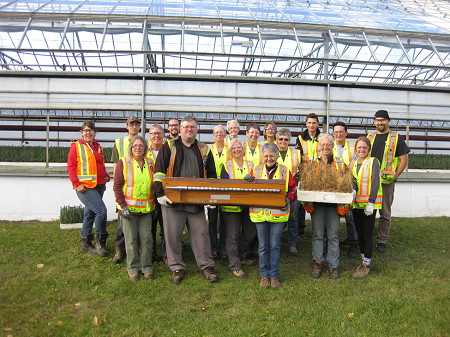Regenerating Forests
Our silviculture program is responsible for creating the forests of tomorrow. To achieve this, our forest professionals must track decades of monitoring surveys over large geographic areas and incorporate the results into current practices. Prompt reforestation of harvested areas is the key to sustainable forest management. This ensures forest productivity is maintained and it gives young trees a head start against competing vegetation to reduce the need for manual or chemical brushing treatments.
Once a new stand is established through natural regeneration and planting, treatments like fill planting, brushing or spacing are sometimes required. This is identified through monitoring surveys. We are responsible for the new forest until it is free growing, which means stands of appropriate species and density have reached a minimum height above brush and are free from insects and disease. This generally takes 10 to 20 years.
Prompt reforestation controls invasive non-native plants, which can be difficult to control and can have a significant impact on timber production and agriculture. They can also alter the structure of natural plant communities and threaten biodiversity.
Canfor uses ecologically suitable species to regenerate all harvested areas to healthy, resilient free-growing forests promptly. We determine the species before we harvest, basing the choice on ecosystem type, forest health issues and potential regeneration risks such as frost, flooding or heavy snow. In 2017, we planted 67 million trees on our tenures, primarily lodgepole pine and hybrid spruce, with a mix of western larch, Douglas-fir, western white pine, ponderosa pine and black spruce where ecologically appropriate.
Canfor owns and operates the J.D. Little Forest Centre near Prince George. In 2017, it celebrated its 35th anniversary of operation and in that time has grown more than 280 million trees. Each year, the J.D. Little Forest Centre grows roughly nine million hybrid spruce trees used in reforestation programs at our Prince George, Vanderhoof, Houston, Mackenzie, Chetwynd and Fort St. John operations, representing 15% of our total seedling needs.
The nursery process simulates three years in the natural environment. Seeds are sown in greenhouses in March, they grow until July when shade cloths are used to restrict daylight, encouraging them to set bud. In mid-October they are lifted, packaged in bundles and frozen. They are thawed in spring and planted within a week. About 98% of the seedlings survive out planting in the bush.

Since 1982, the J.D. Little Forest Centre has produced close to 280 million seedlings.

The J.D. Little Forest Centre is supported by a talented and committed team with 20 seasonal staff during the spring involved in sowing, thinning and shipping, and more than 55 during the fall lift. Throughout the summer months, six full-time employees tend the new crop. The nursery has 10 glass greenhouses and 14 poly greenhouses.
In September, the J.D. Little Forest Centre won the Chief Forester’s award at the Forest Nursery Association of BC annual general meeting in Prince George. The award is presented to the nursery that grows the best quality crop in a desired stock type and species. Our nursery won the award for growing the best western larch seedling out of 15 competing nurseries.
Canfor also manages all stands for a component of natural regeneration - the success depends on a viable seed source, suitable seedbed and proper weather conditions to support seedling growth. We conserve local seed sources to help maintain genetic diversity in regenerated cutblocks. This ensures that tree species are adapted to local conditions, and are more likely to withstand environmental extremes. Genetic diversity will also help buffer future forests from climate change and insect and disease attacks.
Natural regeneration can also contribute to maintaining a diverse mix of species. This is important to mitigate potential forest health impacts. It also provides opportunities to manage the site differently in the future.

Natural regeneration of western larch – the large trees are left for seed.
We use improved or select seed in our reforestation program. Select seed is collected from trees growing in natural forests that exhibit superior traits such as increased growth, pest or disease resistance, or improved form. Controlled breeding of these known parent trees takes place in seed orchards. There is no genetic modification; it involves the careful cross-pollination of trees that exhibit the desired characteristics.
Canfor is part owner in two orchards that grow the select seeds collected from the forest – Vernon Seed Orchard provides some of our select seed for planting in British Columbia and Huallen Seed Orchard Company provides select seed for planting in Alberta. In British Columbia more than 60% of our seedlings are grown from improved seed, and in Alberta almost half of our harvested sites are planted with genetically improved stock.
Using select seed offers a range of biological, social and economic benefits including conservation of genetic diversity, improved forest health, improved forest resiliency, increased site productivity and reduced brushing. One example is the use of weevil resistant spruce in the Prince George area. The use of select seed increases genetic diversity on the landscape because the trees come from a wide geographic area, and the parents are tested to ensure they are suited biologically for the areas where they will be planted. Genetic diversity allows trees to adapt to changes in the environmental conditions.
There are hundreds of provenance test sites across North America where the performance of tree seed progeny is tested and monitored across a variety of sites and climates. This information is used to ensure seed is deployed where it will perform the best, and has allowed us to adapt to climate change through assisted migration.